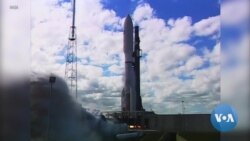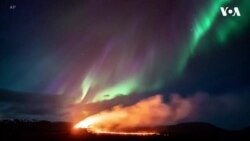ບັນດານັກວິທະຍາສາດອົງການການບິນ ແລະ ອະວະກາດແຫ່ງຊາດ ຂອງ ສະຫະລັດ
ຫຼື NASA ແມ່ນໄດ້ຮັບຂອງຂວັນພິເສດສຳລັບວັນຂຶ້ນປີໃໝ່ນີ້. ຍານອະວະກາດ ນິວ
ໂຮຣາຍສັນສ໌ (New Horizons) ໄດ້ເຄື່ອນເຂົ້າໄປ ໃກ້ເຂດອະວະກາດ ທີ່ຢູ່ໄກອອກ
ໄປຈາກດາວພະເກດ ຫຼື Neptune ທີ່ບໍ່ເຄີຍຖືກສຳຫຼວດມາກ່ອນ ເພື່ອຊອກຄົ້ນຫາ
ວັດຖຸຕ່າງໆທີ່ຢູ່ຫ່າງໄກຫຼາຍຈາກລະບົບ ສຸລິຍະຈັກກະວານ ຂອງພວກເຮົາ ເຊິ່ງມັນ
ອາດຍາກຫຼາຍທີ່ຈະແນມເຫັນດ້ວຍກ້ອງສ່ອງດາວ. ດັ່ງທີ່ນັກຂ່າວວີໂອເອ ເຄວິນ
ອີນັອກສ໌ ລາຍງານນັ້ນ, ການເດີນທາງທີ່ໄກອອກໄປ ໃນອະວະກາດ ອາດຊ່ວຍໃຫ້ບັນ
ດານັກວິທະຍາສາດທັງຫຼາຍຄິດອອກ ວ່າລະບົບສຸລິຍະຈັກກະວານຂອງພວກເຮົາໄດ້
ຖືກສ້າງຂຶ້ນມາແນວໃດ. ພຸດທະສອນ ຈະນຳລາຍລະອຽດມາສະເໜີທ່ານໃນອັນດັບ
ຕໍ່ໄປ.
ນັບຕັ້ງແຕ່ຍານອະວະກາດ ນິວ ໂຮຣາຍສັນສ໌ ໄດ້ບິນອອກຈາກໂລກ ໃນປີ 2006 ນັ້ນ,
ບັນດານັກວິທະຍາສາດ ອົງການ NASA ໄດ້ມີຄວາມຫວັງຢ່າງ ສູງສຳລັບຍານນ້ອຍທີ່
ບໍ່ມີຄົນຂັບນີ້. ແລະໃນສັບປະດານີ້ມັນກໍຈະໄດ້ບັນລຸໜ້າທີ່ຂອງມັນ.
ທ່ານ ອາລັນ ສເຕີນ ຈາກໜ່ວຍປະຕິບັດພາລະກິດ ນິວ ໂຮຣາຍສັນສ໌ ໄດ້ກ່າວວ່າ
“ຍານອະວະກາດ ນິວ ໂຮຣາຍສັນສ໌ ໄດ້ໄປຢູ່ໃນພື້ນທີ່ໆບໍ່ເຄີຍມີການສຳຫຼວດມາກ່ອນ
ເລີຍ ໃນລະບົບສຸລິຍະຈັກກະວານທີ່ເອີ້ນວ່າ ເສັ້ນທາງ ຄຸຍເປີ ຫຼື Kuiper Belt, ມັນ
ແມ່ນວົງຈານຂອງວັດຖຸ ທີ່ເຊື່ອວ່າບັນຈຸດາວເຄາະນ້ອຍຢ່າງຫຼວງຫຼາຍ ທີ່ຫຼົງເຫຼືອຈາກ
ການກໍ່ຕົວຂອງດາວພະເຄາະທັງຫຼາຍ ແລະ ມັນກໍກວ້າງໃຫຍ່ແທ້ໆ. ມັນຈະຢູ່ 4 ພັນ
80ໄ ລ້ານກິໂລແມັດຈາກດວງຕາເວັນ.”
ແລະ ໃນວັນປີໃໝ່ທີ່ຫາກໍຜ່ານມານີ້ ຍານ ນິວ ໂຮຣາຍສັນສ໌ ກໍໄດ້ທຳການບິນຜ່ານຊິ້ນ
ສ່ວນນຶ່ງທີ່ພິເສດຫຼາຍຂອງວັດຖຸທີ່ວ່ານັ້ນ, ເຊິ່ງແມ່ນຊິ້ນສ່ວນກ້ອນຫີນນ້ອຍທີ່ເອີ້ນວ່າ
ອັລຕິມາ ທູລີ (Ultima Thule).
ທ່ານ ອາລັນ ໄດ້ກ່າວວ່າ “ການທີ່ພາກພື້ນນີ້ຂອງລະບົບສຸລິຍະຈັກກະວານຢູ່ຫ່າງ
ຈາກດວງຕາເວັນນັ້ນ ມັນຈະຮັກສາສະພາບດັ້ງເດີມ ຂອງມັນໄວ້ຈາກ 4 ພັນ 5 ຮ້ອຍ
ປີທີ່ຜ່ານມາ ສຳລັບການກໍ່ຕົວດາວພະເຄາະ, ສະນັ້ນເມື່ອພວກເຮົາບິນກາຍກ້ອນຫີນ
ອັລຕິມາ ພວກເຮົາຈະມີໂອກາດໄດ້ເຫັນສິ່ງຕ່າງໆ ໃນແບບທີ່ມັນໄດ້ເປັນ ຢ້ອນກັບ
ໄປໃນຕອນທຳອິດພຸ້ນ.”
ຍານ ນິວ ໂຮຣາຍສັນສ໌ ແມ່ນກຳລັງເດີນທາງດ້ວຍຄວາມໄວ ຫ້າສິບເອັດພັນກິໂລ
ແມັດຕໍ່ຊົ່ວໂມງ ແຕ່ມັນຄວນມີເວລາພໍທີ່ຈະຖ່າຍເອົາຮູບດີໆ ແລະ ຮວບຮວມເອົາ
ຂໍ້ມູນທີ່ລະອຽດ.
ຍານ ນິວ ໂຮຣາຍສັນສ໌ ໄດ້ຖ່າຍຮູບຂອງດາວພະຍົມ ຫຼື Pluto ແລ້ວ, ແຕ່ກ້ອນຫີນ
ທີ່ຈະຖ່າຍເອົານີ້ ແມ່ນມີຂະໜາດນ້ອຍກວ່າຫຼາຍ.
ພາບຖ່າຍເມັດນ້ອຍໆນີ້ ສະແດງໃຫ້ເຫັນລາຍລະອຽດທີ່ວ່າ ມັນນ້ອຍຊ່ຳໃດທີ່ເຮົາ
ຈະສາມາດເຫັນກ້ອນຫີນ ທູລີ ນັ້ນ, ສະນັ້ນການທີ່ຈະເຂົ້າເບິ່ງມັນໃກ້ໆນັ້ນແມ່ນບັນ
ຫາທີ່ໃຫຍ່ຫຼາຍສຳລັບອົງການ NASA.
ທ່ານ ອາລັນ ເວົ້າວ່າ “ຢູ່ໄລຍະທີ່ໃກ້ທີ່ສຸດນັ້ນ ພວກເຮົາຈະພະຍາຍາມເຮັດ ແລະ
ຖ່າຍຮູບເອົາກ້ອນຫີນ ທູລີ ໃຫ້ໄດ້ຄວາມລະອຽດ 3 ເທື່ອຫຼາຍກວ່າທີ່ເຮົາໄດ້ຖ່າຍເອົາ
ປລູໂຕ ນັ້ນ, ຖ້າພວກເຮົາສາມາດເຮັດໄດ້ສຳເລັດ ມັນຄົງຈະສຸດ ຍອດໄປເລີຍ.”
ຫຼັງຈາກຖ່າຍຮູບກ້ອນຫີນອະວະກາດ ອັລຕິມາ ແລ້ວ, ບັນດານັກວິທະຍາສາດກ່າວ
ວ່າ ຍານ ນິວ ໂຮຣາຍສັນສ໌ ຈະມີເຊື້ອໄຟພຽງພໍ ເພື່ອເຮັດວຽກຈົນຮອດປະມານປີ
2026.
NASA scientists are getting a very special New Year's Day gift. The New Horizons spacecraft is moving into unexplored space beyond Neptune to explore objects so far out in our solar system they can hardly be seen by telescope. As VOA's Kevin Enochs reports, the trip far out in space may help scientists figure out how the solar system was created.
Ever since the New Horizons space craft left earth in 2006, NASA scientists have had high hopes for this little unmanned ship. And this week it makes good on that promise.
New Horizons is in a completely unexplored region of the solar system called the Kuiper Belt, ((CUT)) it's a disc of material left over from the formation of the planets and it's really vast. It begins 3 billion miles (4.8 billion kilometers) from the sun."
And New Horizons is going to do a New Years Day fly by of one very special piece of that material, a small piece of rock called Ultima Thule ((TOO-lee)).
"This region of the solar system being so far from the sun preserves the original conditions from 4.5 billion years ago for planetary formation, so when we fly by Ultima we're going to have a chance to see things the way they were back at the beginning."
New Horizons is traveling 51-thousand kilometers per hour but should have enough time to take great pictures and gather solid information.
New Horizons has already imaged Pluto, but this is a much smaller target.
This grainy sequence shows how little detail we can see of Thule, so getting such a close look is a big deal for NASA.
"At closest approach we're going to try and image Ultima at 3 times the resolution that we had for Pluto, if we can accomplish that it'll be spectacular."
After Ultima, scientists say New Horizons has enough fuel to keep working until about 2026.










